Normally-off β-Ga2O3 MOSFET with an Epitaxial Drift Layer
Abstract
:1. Introduction
2. Simulation and Device Structure
2.1. Mobility Model
2.2. Impact Ionization Model
2.3. Shockley–Read–Hall Recombination
2.4. Device Structure
3. Results and Discussions
3.1. Effects of Al2O3/β-Ga2O3 Interface Charge
3.2. Effects of Doping Concentrations in Body and Drift Layer
3.3. Effects of Drift Layer Thickness
3.3.1. Transfer and Output Characteristics
3.3.2. Breakdown Characteristics
4. Conclusions
Author Contributions
Funding
Conflicts of Interest
References
- Lee, I.; Kumar, A.; Zeng, K.; Singisetti, U.; Yao, X. Mixed-mode circuit simulation to characterize Ga2O3 MOSFETs in different device structures. In Proceedings of the IEEE 5th Workshop on Wide Bandgap Power Devices and Applications (WiPDA), Albuquerque, NM, USA, 30 October–1 November 2017. [Google Scholar] [CrossRef]
- Kim, K.H.; Choa, S.H. Recent overview on power semiconductor devices and package module technology. J. Microelectron. Packag. Soc. 2019, 26, 15–22. [Google Scholar] [CrossRef]
- Lv, Y.; Zhou, X.; Long, S.; Liang, S.; Song, X.; Zhou, X.; Dong, H.; Wang, Y.; Feng, Z.; Cai, S. Lateral source field-plated β-Ga2O3 MOSFET with recorded breakdown voltage of 2360 V and low specific on-resistance of 560 mΩ cm2. Semicond. Sci. Technol. 2019, 34, 11LT02. [Google Scholar] [CrossRef]
- Kim, H.S.; Mingi, J.; Cha, H.Y. Schottky barrier diode fabricated on single crystal β-Ga2O3 semiconductor. J. Inst. Electron. Inf. Eng. 2017, 54, 21–25. [Google Scholar] [CrossRef]
- Chabak, K.; Walker, D.E.; Green, A.J. Sub-Micron Gallium Oxide Radio Frequency Field-Effect Transistors. In Proceedings of the IEEE MTT-S International Microwave Workshop Series on Advanced Materials and Processes for RF and THz Applications (IMWS-AMP), Ann Arbor, MI, USA, 16–18 July 2018. [Google Scholar] [CrossRef]
- Singh, R.; Lenka, T.R.; Panda, D.K.; Velpula, R.T.; Jain, B.; Bui, H.Q.T.; Nguyen, H.P.T. The dawn of Ga2O3 HEMTs for high power electronics—A review. Mater. Sci. Semicond. Process 2020, 119, 105216. [Google Scholar] [CrossRef]
- Mun, J.K.; Cho, K.; Chang, W.; Jung, H.W.; Do, J. 2.32 kV breakdown voltage lateral β-Ga2O3 MOSFETs with source-connected field plate. ECS J. Solid State Sci. Technol. 2019, 8, Q3079. [Google Scholar] [CrossRef]
- Roberts, J.W.; Chalker, P.R.; Ding, B.; Oliver, R.A.; Gibbon, J.T.; Jones, L.A.H.; Dhanak, V.R.; Philips, L.J.; Major, J.D.; Massabuau, F.C.P. Low temperature growth and optical properties of α-Ga2O3 deposited on sapphire by plasma enhanced atomic layer deposition. J. Cryst. Growth 2019, 528, 125254. [Google Scholar] [CrossRef]
- Ren, F.; Yang, J.C.; Fares, C.; Pearton, S.J. Device processing and junction formation needs for ultra-high power Ga2O3 electronics. MRS Commun. 2019, 9, 77. [Google Scholar] [CrossRef]
- Xue, H.; He, Q.; Jian, G.; Long, S.; Pang, T.; Liu, M. An overview of the ultrawide bandgap Ga2O3 semiconductor-based schottky barrier diode for power electronics application. Nanoscale Res. Lett. 2018, 13, 290. [Google Scholar] [CrossRef]
- Ghosh, K.; Singisetti, U. Impact ionization in β-Ga2O3. J. Appl. Phys. 2018, 124, 085707. [Google Scholar] [CrossRef]
- Labed, M.; Swngouga, N.; Meftah, A.; Labed, M.; Kyoung, S.; Kim, H.; Rim, Y.S. Leakage Current Modelling and Optimization of β-Ga2O3 Schottky Barrier Diode with Ni Contact under High Reverse Voltage. ECS J. Solid State Sci. Technol. 2020, 9, 125001. [Google Scholar] [CrossRef]
- Krytsos, A.; Matsubara, M.; Bellotti, E. On the feasibility of p-type Ga2O3. Appl. Phys. Lett. 2018, 112, 032108. [Google Scholar] [CrossRef]
- Lv, Y.; Mo, J.; Song, X.; He, Z.; Wang, Y.; Tan, X.; Zhou, X.; Gu, G.; Guo, H.; Feng, Z. Influence of gate recess on the electronic characteristics of β-Ga2O3 MOSFETs. Superlattices Microstruct. 2018, 117, 132–136. [Google Scholar] [CrossRef]
- Chabak, K.D.; Moser, N.; Green, A.J.; Walker, D.E., Jr.; Tetlak, S.E.; Heller, E.; Crespo, A.; Fitch, R.; McCandless, J.P.; Leedy, K.; et al. Enhancement-mode Ga2O3 wrap-gate fin field-effect transistors on native (100) β-Ga2O3 substrate with high breakdown voltage. Appl. Phys. Lett. 2016, 109, 213501. [Google Scholar] [CrossRef]
- Chabak, K.D.; McCandless, J.P.; Moser, N.A. Recessed-gate enhancement-mode β-Ga2O3 MOSFETs. IEEE Electron Device Lett. 2018, 39, 67–70. [Google Scholar] [CrossRef]
- Singh, R.; Lenka, T.R.; Velpula, R.T.; Thang, B.H.Q.; Nguyen, H.P.T. Investigation of E-mode beta-gallium oxide MOSFET for emerging nanoelectronics. In Proceedings of the IEEE 14th Nanotechnology Materials and Devices Conference, Stockholm, Sweden, 27–30 October 2019; Volume 27–30. [Google Scholar] [CrossRef]
- Lv, Y.; Liu, H.; Zhou, X.; Wang, Y.; Song, X.; Cai, Y.; Yan, Q.; Wang, C.; Liang, S.; Zhang, J.; et al. Lateral β-Ga2O3 MOSFETs With High-Power Figure of Merit of 277 MW/cm2. IEEE Electron Device Lett. 2020, 41, 537. [Google Scholar] [CrossRef]
- Wong, M.H.; Nakata, Y.; Kuramata, A.; Yamakoshi, S.; Higashiwaki, M. Enhancement-mode Ga2O3 MOSFETs with Si-ion-implanted source and drain. Appl. Phys. Express 2017, 10, 041101. [Google Scholar] [CrossRef]
- Park, J.; Hong, S.M. Simulation study of enhancement mode multi-gate vertical gallium oxide MOSFETs. ECS J. Solid State Sci. Technol. 2019, 8, Q31116. [Google Scholar] [CrossRef]
- Huang, X.; Liao, F.; Li, L.; Liang, X.; Liu, Q.; Zhang, C.; Hu, X. 3.4 kV breakdown voltage Ga2O3 trench Schottky diode with optimized trench corner radius. ECS J. Solid State Sci. Technol. 2020, 9, 045012. [Google Scholar] [CrossRef]
- Choi, J.H.; Cho, C.-H.; Cha, H.-Y. Design consideration of high voltage Ga2O3 vertical Schottky barrier diode with field plate. Results Phys. 2018, 9, 1170. [Google Scholar] [CrossRef]
- Madadi, D.; Orouji, A.A. Investigation of Short Channel Effects in SOI MOSFET with 20 nm Channel Length by a β-Ga2O3 Layer. ECS J. Solid State Sci. Technol. 2020, 9, 045002. [Google Scholar] [CrossRef]
- Silvaco Atlas User’s Manual Device Simulation Software; SILVACO International: Santa Clara, CA, USA, 2012; 169p.
- Caughey, D.; Thomas, R. Carrier mobilities in silicon empirically related to doping and field. Proc. IEEE 1967, 55, 2192–2193. [Google Scholar] [CrossRef]
- Shockley, W.; Read, W.T. Statistics of the Recombinations of Holes and Electrons. Phys. Rev. 1952, 87, 835. [Google Scholar] [CrossRef]
- Khodadadiana, A.; Parvizia, M.; Heitzinger, C. An adaptive multilevel Monte Carlo algorithm for the stochastic drift-diffusion-Poisson system. Comput. Methods Appl. Mech. Eng. 2020, 368, 113163. [Google Scholar] [CrossRef]
- Poncé, S.; Li, W.; Reichardt, S.; Giustino, F. First-principles calculations of charge carrier mobility and conductivity in bulk semiconductors and two-dimensional materials. Rep. Prog. Phys. 2020, 83, 036501. [Google Scholar] [CrossRef] [PubMed]
- Parisini, A.; Fornari, R. Analysis of the scattering mechanisms controlling electron mobility in β-Ga2O3 crystals. Semicond. Sci. Technol. 2016, 31, 035023. [Google Scholar] [CrossRef]
- Tetzner, K.; Treidel, E.B.; Hilt, O.; Popp, A.; Anooz, S.B.; Wagner, G.; Thies, A.; Ickert, K.; Gargouri, H.; Wurfl, J. Lateral 1.8 kV β-Ga2O3 MOSFET with 155 MW/cm2 power figure of merit. IEEE Electron Device Lett. 2019, 40, 1503. [Google Scholar] [CrossRef]
- Hung, T.-H.; Sasaki, K.; Kuramata, A.; Nath, D.N.; Park, P.S.; Polchinski, C.; Rajan, S. Energy band line-up of atomic layer deposited Al2O3 on β-Ga2O3. Appl. Phys. Lett. 2014, 104, 162106. [Google Scholar] [CrossRef]
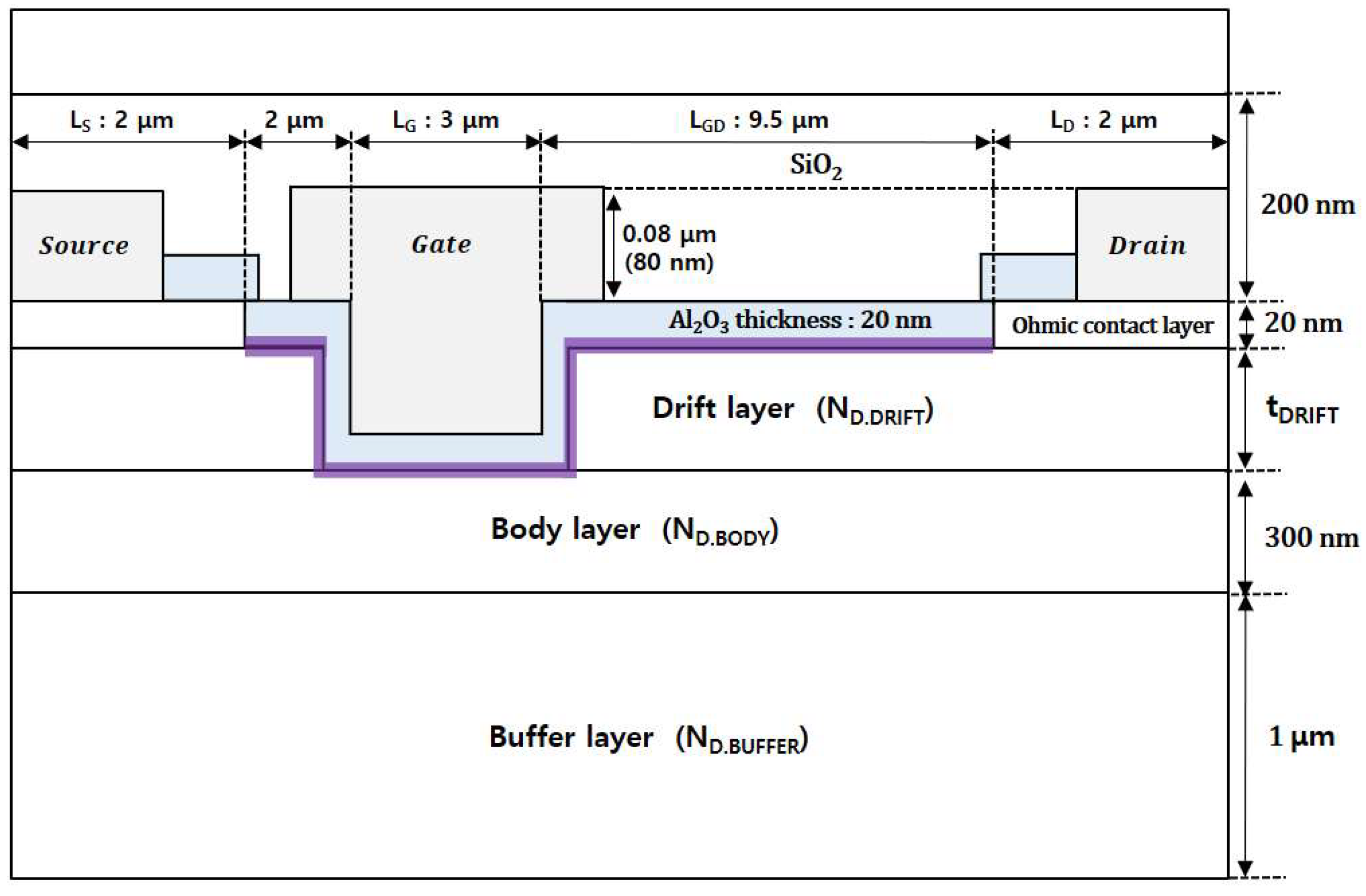


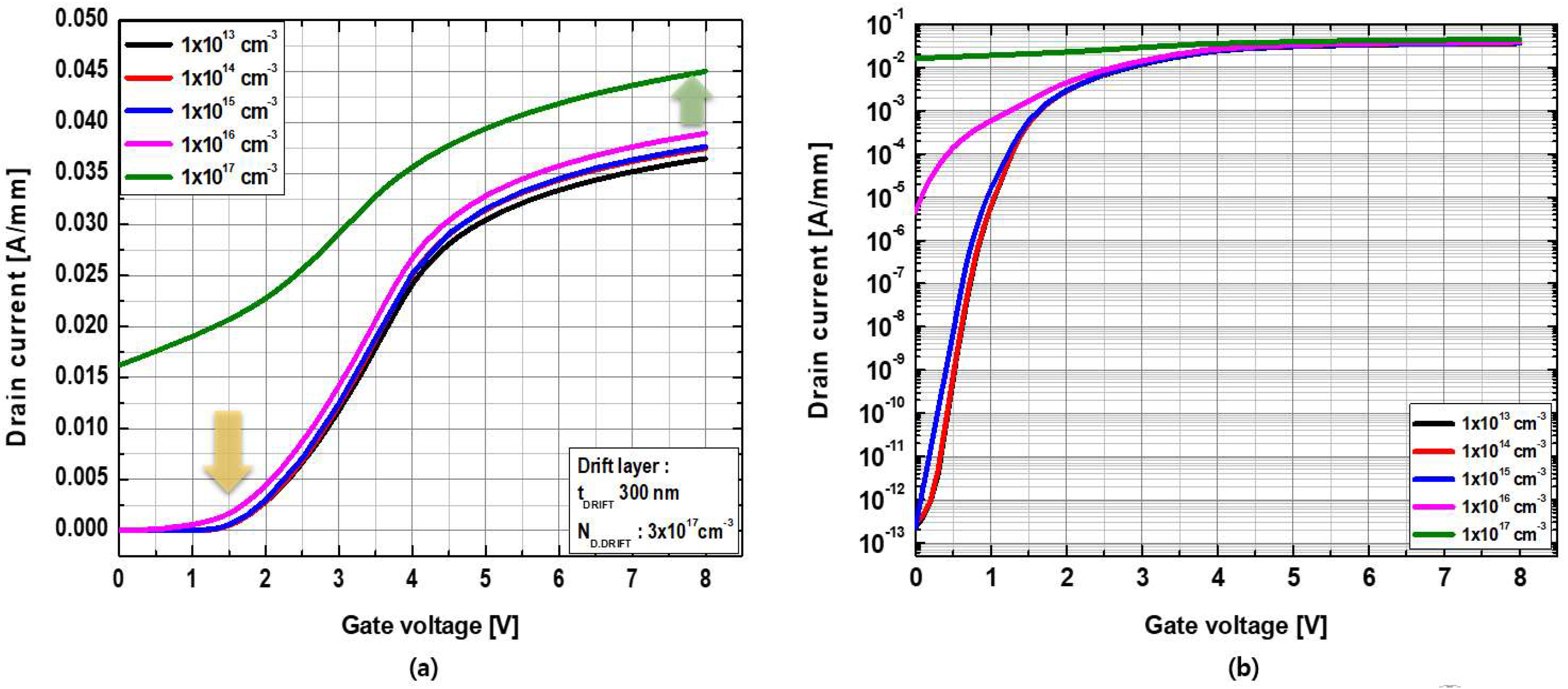
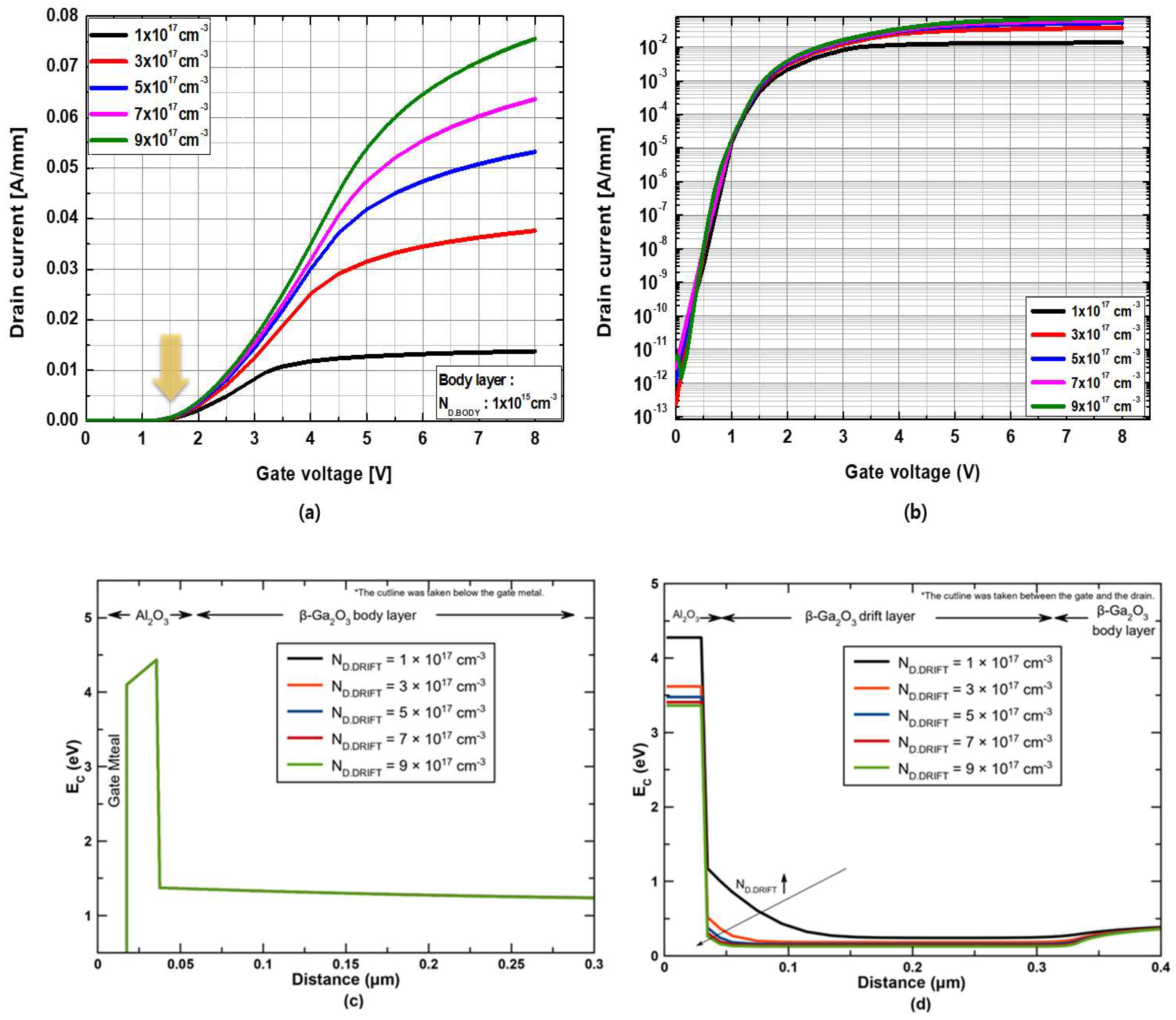
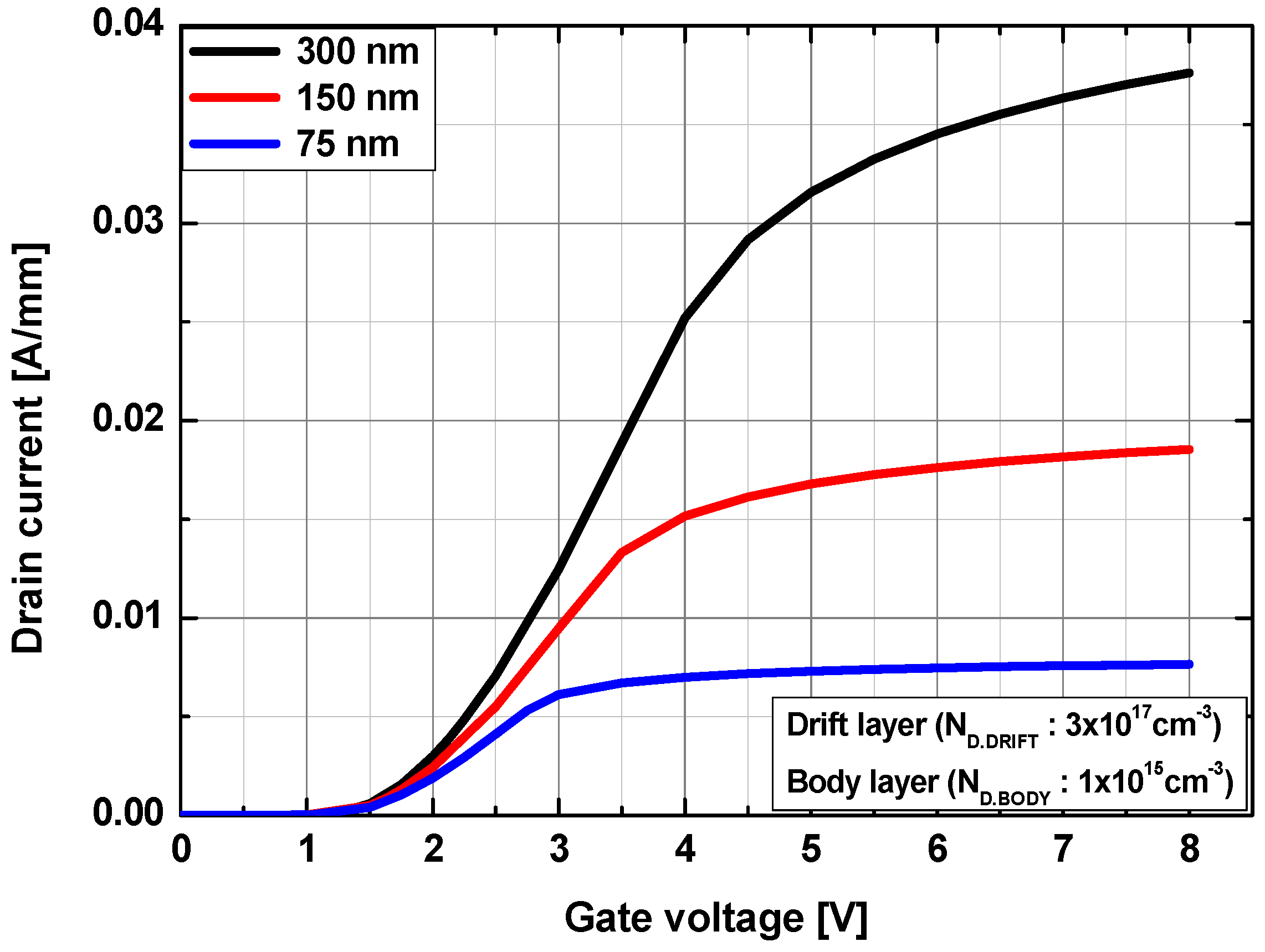
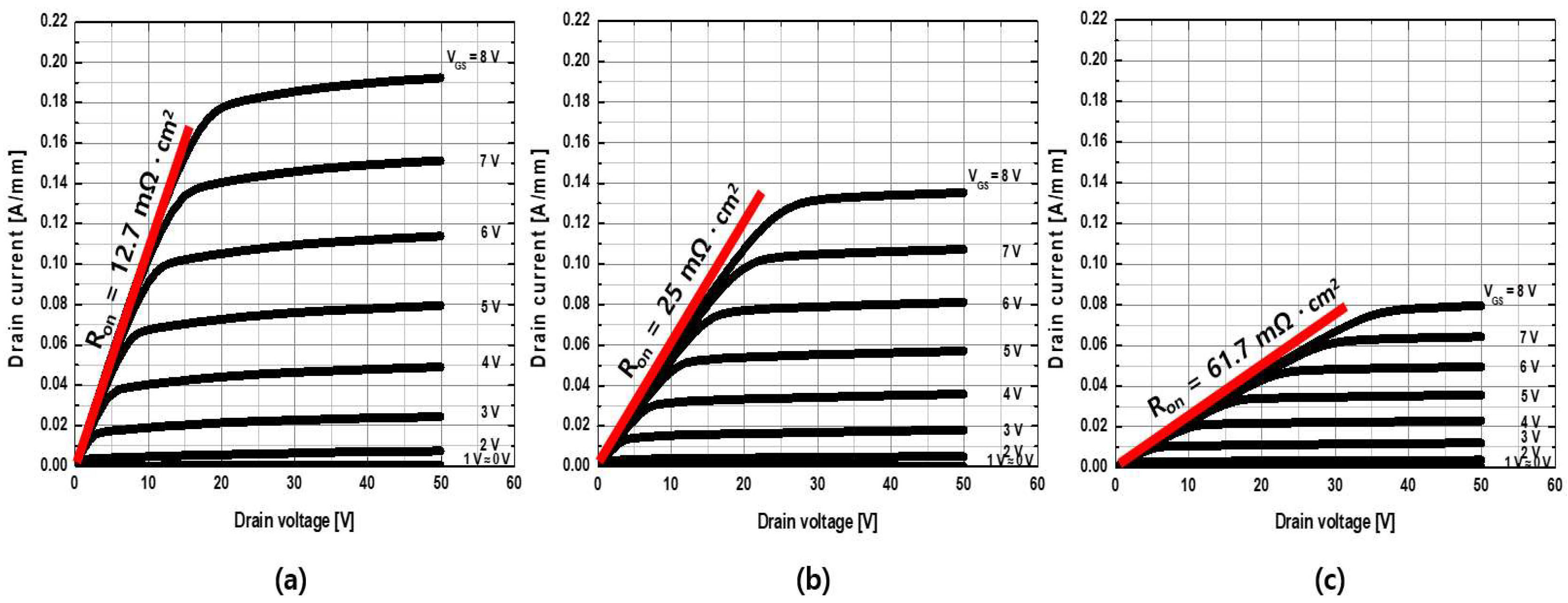
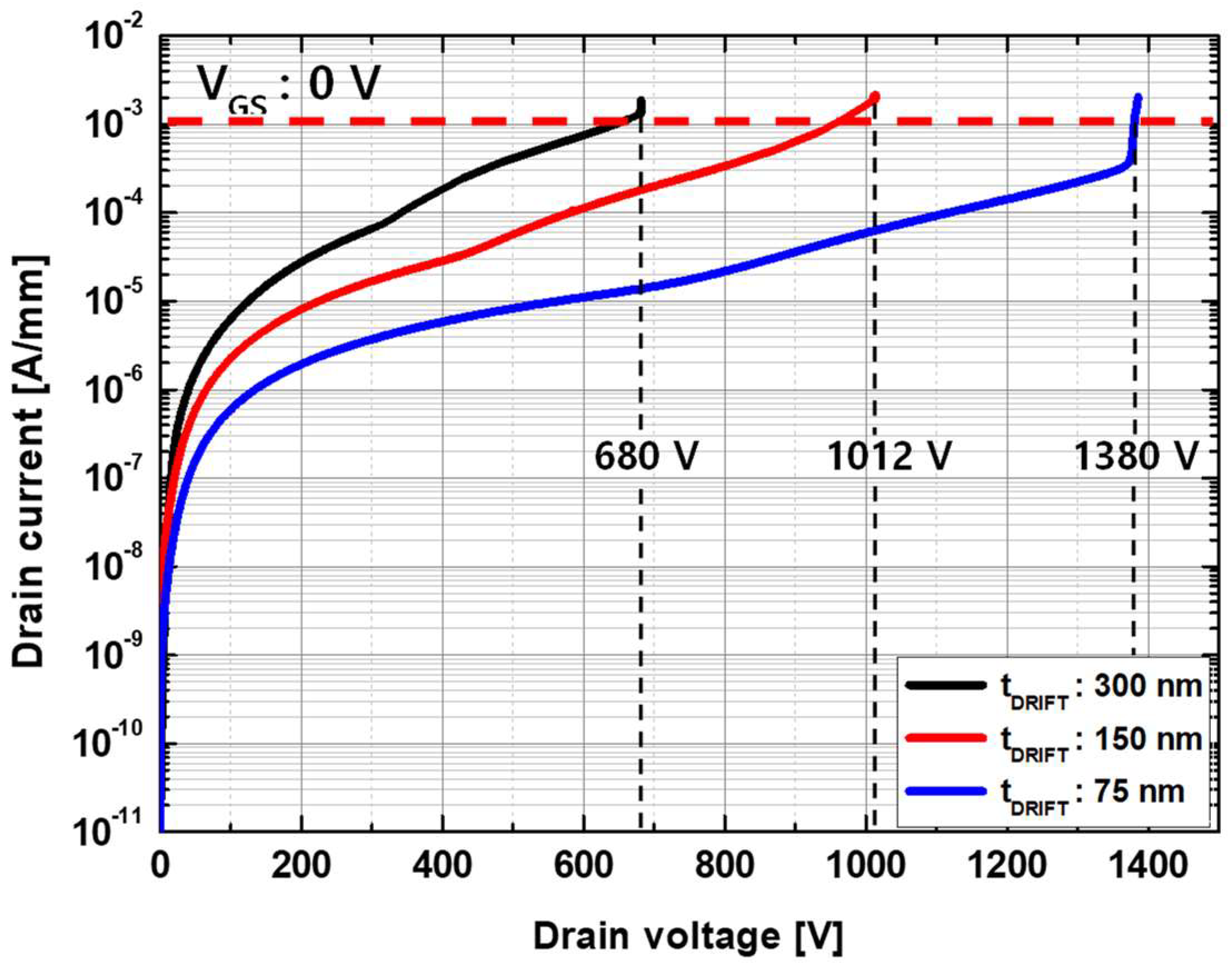
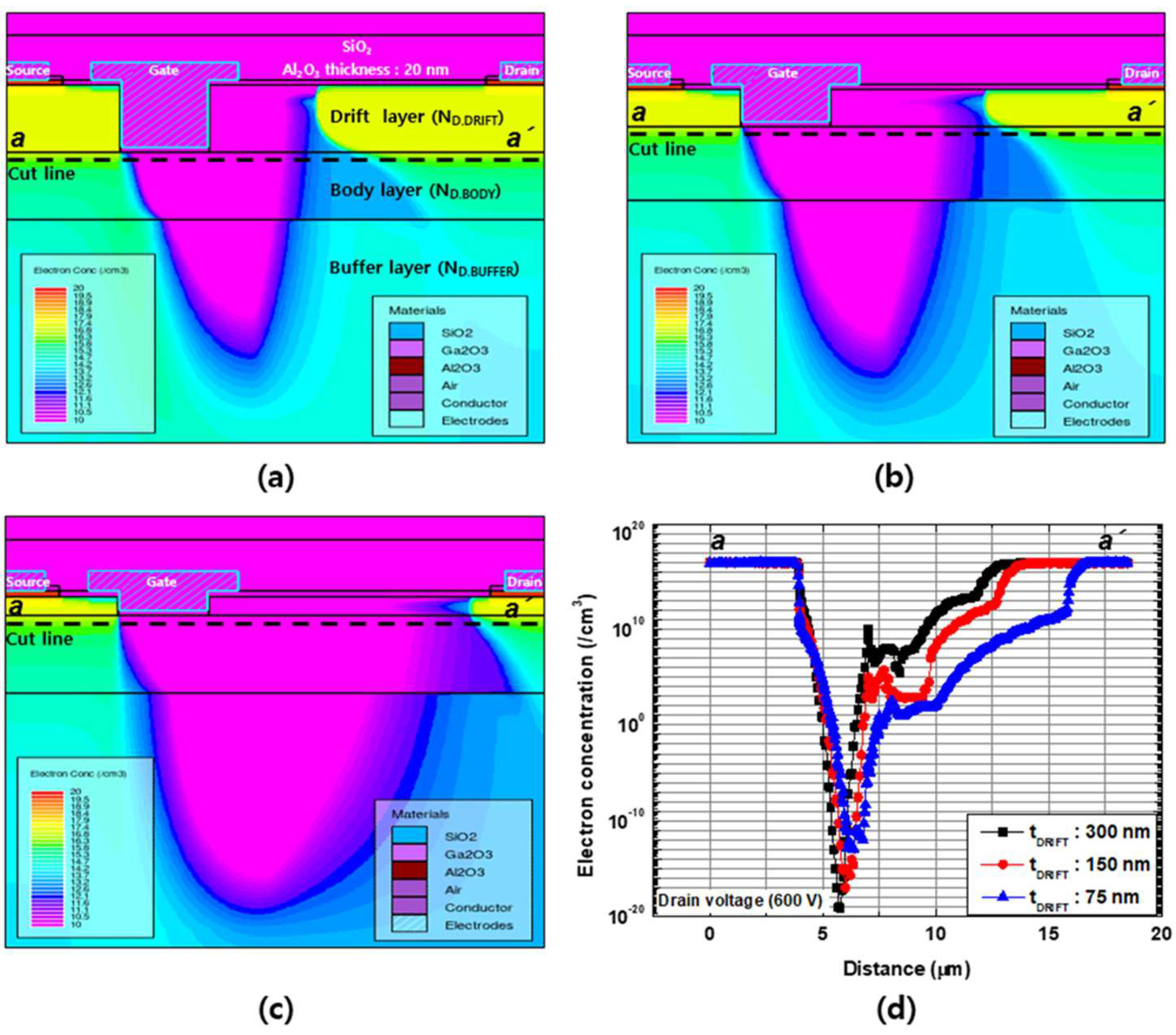


| Material Parameters | |
|---|---|
| Affinitivity | 4.0 eV |
| Band gap (300 K) | 4.8 eV |
| Permittivity | 10.2 |
| Mobility Model | |
| μmin | 20 cm2/Vs |
| μmax | 155 cm2/Vs |
| α | 0 |
| β | 0 |
| γ | 0 |
| δ | 0.8 |
| Nref | 1.0 × 1018 cm−3 |
| TL | 300 K |
| Impact Ionization Model | |
| AN | 2.16 × 106 cm−1 |
| BN | 1.77 × 107 V/cm |
| Shockley–Read–Hall Recombination Model | |
| τn0 | 1.2 × 10−8 s |
| τp0 | 1.2 × 10−8 s |
Publisher’s Note: MDPI stays neutral with regard to jurisdictional claims in published maps and institutional affiliations. |
© 2022 by the authors. Licensee MDPI, Basel, Switzerland. This article is an open access article distributed under the terms and conditions of the Creative Commons Attribution (CC BY) license (https://creativecommons.org/licenses/by/4.0/).
Share and Cite
Jang, C.-H.; Atmaca, G.; Cha, H.-Y. Normally-off β-Ga2O3 MOSFET with an Epitaxial Drift Layer. Micromachines 2022, 13, 1185. https://doi.org/10.3390/mi13081185
Jang C-H, Atmaca G, Cha H-Y. Normally-off β-Ga2O3 MOSFET with an Epitaxial Drift Layer. Micromachines. 2022; 13(8):1185. https://doi.org/10.3390/mi13081185
Chicago/Turabian StyleJang, Chan-Hee, Gökhan Atmaca, and Ho-Young Cha. 2022. "Normally-off β-Ga2O3 MOSFET with an Epitaxial Drift Layer" Micromachines 13, no. 8: 1185. https://doi.org/10.3390/mi13081185
APA StyleJang, C.-H., Atmaca, G., & Cha, H.-Y. (2022). Normally-off β-Ga2O3 MOSFET with an Epitaxial Drift Layer. Micromachines, 13(8), 1185. https://doi.org/10.3390/mi13081185






